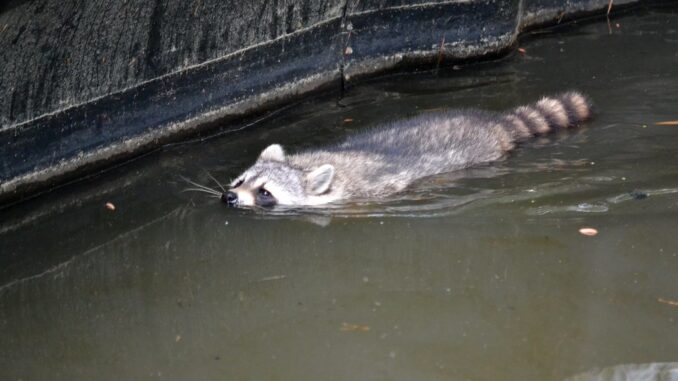
Can raccoons swim? The answer is a resounding yes! Raccoons, those curious and adaptable creatures, are surprisingly skilled swimmers. Research reveals that these adaptable mammals can swim at an average speed of 5 kilometres per hour and remain submerged for several hours, showcasing their prowess in aquatic environments.
Raccoons exhibit various behaviors in water, including crawling, standing, and even diving. Their sharp claws aid in swift movements, facilitating the capture of water animals. Despite variations in body structures, urban raccoons typically possess bodies capable of withstanding strong water currents during swims.
Table of Contents
Why Can Raccoons Swim? Unveiling the Purpose
Raccoons are often found near water sources. This is not a coincidence; their swimming ability serves practical purposes, from foraging for food to navigating their surroundings. Understanding the reasons behind their affinity for water adds depth to our appreciation of these clever mammals.
Foraging for Food: Raccoons are opportunistic feeders. Their aquatic expeditions are not merely for leisure; they actively search for aquatic prey, such as fish, turtles, frogs, and even small crustaceans. Their ability to swim broadens their dietary options and enhances their survival skills.
Escape Mechanism: Swimming provides raccoons with an effective means of escape from predators. They can quickly enter the water and swim away from potential threats, using it as a defensive strategy.
Nesting Sites: Raccoons may use water-adjacent areas for nesting sites. Being able to swim allows them to access secluded locations for building nests and providing shelter for their young.
Temperature Regulation: Raccoons can regulate their body temperature by swimming. Water helps cool them down during hot weather, and they may swim to maintain a comfortable temperature.
Exploration and Navigation: Water bodies often serve as natural barriers or landmarks in a raccoon’s environment. Swimming allows them to explore and navigate through their surroundings more effectively.
Raccoons in Swimming Pools
Originally inhabitants of deciduous forests, raccoons have migrated to marshy areas and coastal regions, necessitating the development of swimming skills. In urban settings, they employ these skills to catch insects and sea animals in streams and bodies of water.
Raccoons enter swimming pools for various reasons, including foraging for food such as fish, escaping predators, satisfying their curiosity, seeking shelter or nesting spots, cooling off in warm weather, and being attracted by reflections or debris.
Additionally, the availability of water in pools may fulfill their hydration needs, and their innate swimming skills, developed in natural habitats, persist in urban settings. Implementing preventive measures, such as secure fencing and removal of attractants, is crucial for managing raccoon interactions with swimming pools and ensuring a harmonious coexistence.
Preventing Raccoon from Entering Pools and Private Water Springs
Install Raccoon-Proof Barriers: Erect a sturdy fence around your pool or water spring. Ensure it extends below ground level to prevent digging. Opt for materials like metal or wood, and ensure the fence is tall enough (at least 3 feet for pools) to discourage climbing.
Motion-Activated Lights: Install motion-activated lights around the pool or water spring area. Raccoons are nocturnal, and sudden illumination can startle them, discouraging their presence.
Floating Pool Covers: Use floating pool covers when the pool is not in use. This not only helps in preventing debris but also acts as a physical barrier, deterring raccoons.
Secure Trash Containers: Raccoons are often attracted to food sources. Ensure trash containers around the pool or water spring are securely closed with locking lids to minimize the appeal.
Remove Attractive Objects: Keep potential attractants away from the pool area. This includes pet food, fallen fruits, or any items that might entice raccoons.
Trim Overhanging Branches: Trim branches that hang over the pool or water spring. Raccoons are agile climbers, and removing this access point makes it harder for them to reach the area.
Chemical Deterrents: Consider using raccoon deterrents such as commercial repellents or homemade solutions with ingredients like garlic or chilli pepper. Apply these around the pool perimeter.
Professional Assistance: If raccoon intrusion persists, consider seeking professional help. Animal control services or pest control experts can provide effective and humane solutions tailored to your specific situation.
Frequently Asked Questions (FAQs) About Raccoon Swimming Abilities
Q1: Can raccoons swim for long periods?
A: Yes, raccoons are capable of swimming for a long time. Their unique physiology allows them to remain submerged for several minutes, showcasing impressive underwater endurance compared to other mammals.
Q2: What strokes can raccoons perform in water?
A: Raccoons exhibit various swimming maneuvers, including crawling and standing in water. Their agile movements, aided by sharp claws, enable them to navigate water environments swiftly. While not known for specific swimming strokes, their adaptability allows them to employ diverse techniques.
Q3: Do raccoons naturally possess swimming skills?
A: Yes, raccoons are naturally adept swimmers. Originating from habitats near water sources like marshy areas, they have developed innate swimming skills over time. This adaptation persists even in urban environments.
Q4: Are raccoons comfortable in cold water?
A: Raccoons can tolerate cold water, thanks to their skin composition, which comprises over 85% fur. This high fur content acts as insulation, allowing them to swim comfortably in extremely cold conditions. Their adaptation includes using their skin as an extra insulator during temporary hibernation.
Q5: Can raccoons dive underwater?
A: Raccoons can indeed dive underwater, reaching depths of about 5 feet. Their ability to submerge enables them to catch prey and navigate water environments effectively. Their unique breathing mechanisms contribute to their survival underwater for several minutes, showcasing their aquatic versatility.
Conclusion:
In conclusion, the revelation of raccoons’ swimming abilities adds a fascinating dimension to our understanding of these resourceful mammals. From urban escapades to foraging expeditions, raccoons showcase adaptability and intelligence in their aquatic endeavors. Coexisting with these clever swimmers involves understanding their behaviors and taking preventive measures to ensure harmonious living in shared spaces.
